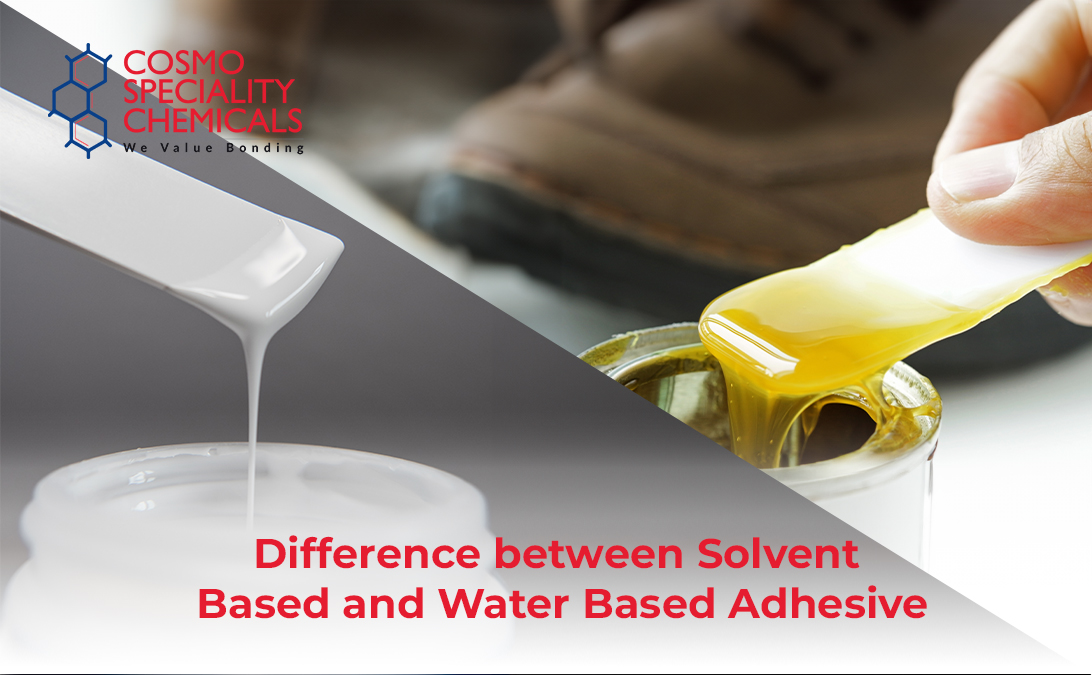
Two prominent categories of adhesives within the tech driven adhesive industry are the choice between solvent based and solvent less adhesives. They are significantly different in their composition, application and characteristics and play a crucial role in ensuring the overall success of any project.
Solvent less adhesives are 100% solid and do not carry any volatile organic compounds. They are increasingly becoming popular due to their clean-green sustainable formulation and high compliance to health & safety regulations.
Solvent based adhesives on the other hand carry volatile solvent that evaporate to form bonds.
What are solvents?
Solvents play a crucial role in adhesive industry. They are used to dilute, dissolve, or disperse adhesive components and aid the application process. Solvents help the adhesive manufacturers in achieving the desired consistency for applications. It controls the viscosity and improves the functional efficiency of the adhesive by facilitating even coating of the substrate and faster curing that enables strong bonds.
What are different types of solvents used by adhesive manufacturers?
The adhesive industry uses a variety of solvents for the different properties they bring to the adhesive formulations. The most common types of solvents used in adhesive manufacturing are:
Ethanol – Ethanol or ethyl alcohol are easy to mix with water and evaporate quickly. They are generally used to dilute adhesive formulations and are useful to reduce the viscosity. It can be also used as a secondary solvent in water-based adhesives to improve wetting properties and reduce surface tension. Common applications of ethanol solvent are in pharmaceutical adhesives.
Xylene – Xylene based adhesives provide strong adhesion to a variety of substrates. Commonly used in speciality applications, xylene offers a balance between drying time and workability. It allows proper bonding without overly fast or slow curing.
Toluene – Toluene is a clear, colourless liquid with an aroma. It is generally found in solvent based adhesives used primarily in automotive and construction industries. Toluene is a hydrocarbon with excellent solubility with various organic compounds.
Ethyl Acetate – Ethyl acetate is a common adhesive solvent well known for its ability to dissolve a wide variety of resins, polymers, and adhesive components. It is volatile, colourless liquid with a sweet aroma. It is considered less harmful than some other solvents due to its relatively lower toxicity.
Methyl Ethyl Ketone – MEK is also known as 2-Butanone. It has a fast evaporation rate which makes it suitable for applications where rapid drying and bond formation are necessary. It is valued in adhesive industry for its compatibility with various adhesives components and is used in production of adhesives that can be used in laminating, flexible packaging, bonding rubber materials, automotive and aerospace industries.
How is Solvent based PU Adhesive different from Solventless PU Adhesive?
Polyurethane adhesives play a vital role a wide array of industries. They are versatile adhesives used to bond two or more substrates together according to specific application need. When it comes selecting the right PU adhesive various parameters need to be taken under consideration. However, one of the fundamental choices is between solvent based and solventless PU adhesive formulations.
What are solvent based PU Adhesives?
Solvent based polyurethane adhesives use volatile organic compounds to carry the adhesive components. They generally contain Toluene, Acetone, MEK or Xylene solvents that help the adhesive to spread easily and form strong bonds essentially.
Solvent based PU adhesives are used in flexible packaging and are ideal for assembly line production in various industries. These adhesives are highly versatile and provides exceptional compatibility with a variety of substrates.
What are the advantages of Solvent based PU adhesives?
Fast curing in high-speed production environment is a major advantage of solvent based PU adhesive. They create strong, durable bonds and are less expensive to their alternatives.
What are the disadvantages of Solvent based PU adhesives?
What are solvent less PU adhesives?
Solvent-less PU adhesives do not contain volatile organic compounds. Typically, a two- component formulation that require mixing before applications, these polyurethanes are well known for their adhesion, high mechanical properties, and good chemical resistance. Compared to one component PU adhesives, two component adhesives cure faster and don’t need the addition of moisture or heat to set. Solvent-less Polyurethane adhesives cure through chemical reactions without need for solvent evaporation.
Solventless polyurethane adhesives are highly suitable for use in flexible food packaging and lamination due to its low toxicity. It also reduces the risk of solvent penetration in films and foils.
What are the advantages of Solventless PU adhesives?
What are the disadvantages of Solventless PU adhesives?
Why choose Cosmo Solventless PU adhesives?
Cosmo speciality Chemicals 2-component Solventless polyurethane adhesives is combination package of polyols and poly-isocyanates pre-polymers. It offers good clarity on metallized laminates at higher speeds and has good heat seal and bond strengths on various substrates. Cosmo Solventless PU adhesives are well suited for a variety of general to high performance applications. These are cost efficient, strong bonding solutions with long pot life that ensure defect free production.
To know more about Cosmo Specialty Chemicals sustainable PU adhesives, connect with Cosmo chemicals experts today.
Featured Post